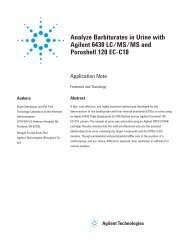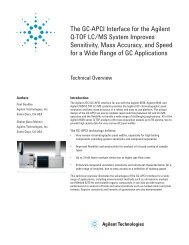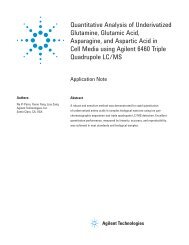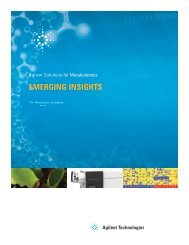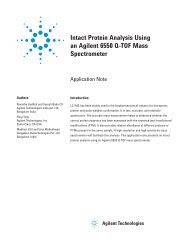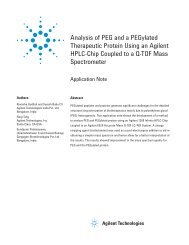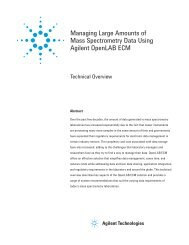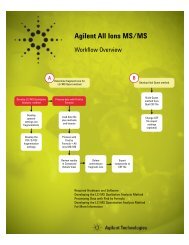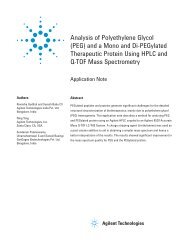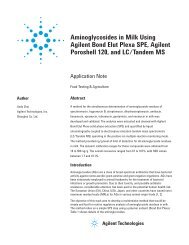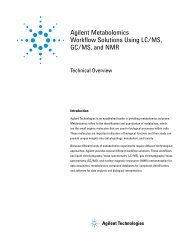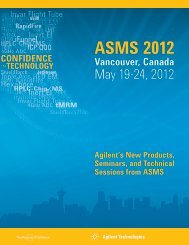pharmaceutical impurity analysis solutions - Lcms-connect.com
pharmaceutical impurity analysis solutions - Lcms-connect.com
pharmaceutical impurity analysis solutions - Lcms-connect.com
Create successful ePaper yourself
Turn your PDF publications into a flip-book with our unique Google optimized e-Paper software.
1PHARMACEUTICAL IMPURITY ANALYSIS –OVERVIEW AND REGULATORY SITUATIONPharmaceuticals impurities are the unwanted chemicals that remain with active<strong>pharmaceutical</strong> ingredients (API) or drug product formulations. The impuritiesobserved in drug substances may arise during synthesis or may be derived fromsources such as starting materials, intermediates, reagents, solvents, catalysts, andreaction by-products. During drug product development, impurities may be formed asa result of the inherent instability of drug substances, may be due to in<strong>com</strong>patibilitywith added excipients, or may appear as the result of interactions with packagingmaterials. The amount of various impurities found in drug substances will determinethe ultimate safety of the fi nal <strong>pharmaceutical</strong> product. Therefore, the identifi cation,quantitation, qualifi cation, and control of impurities are now a critical part of thedrug development process.Various regulatory authorities focus on the control of impurities: the InternationalConference on Harmonization (ICH), the United States Food and Drug Administration(USFDA), the European Medicines Agency (EMA), the Canadian Drug and HealthAgency, the Japanese Pharmaceutical and Medical Devices Agency (PMDA), andthe Australian Department of Health and Ageing Therapeutic Goods. In addition, anumber of offi cial <strong>com</strong>pendia, such as the British Pharmacopoeia (BP), the UnitedStates Pharmacopeia (USP), the Japanese Pharmacopoeia (JP), and the EuropeanPharmacopoeia (EP) are incorporating limits that restrict the <strong>impurity</strong> levels present inAPIs as well as in drug formulations.The Three Major Categoriesof Pharmaceutical ImpuritiesAccording to ICH guidelines, impurities related to drug substances can be classifi ed intothree main categories: organic impurities, inorganic impurities, and residual solvents.1. Organic impuritiesOrganic impurities can arise in APIs or drug product formulations during themanufacturing process or during the storage of drug substances. They may beknown, unknown, volatile, or non-volatile <strong>com</strong>pounds with sources including startingmaterials, intermediates, unintended by-products, and degradation products. Theymay also arise from racemization, or contamination of one enantiomeric form withanother. In all cases they can result in undesired biological activity.Recently, genotoxic <strong>pharmaceutical</strong> impurities, which may potentially increasecancer risks in patients, have received considerable attention from regulatorybodies and <strong>pharmaceutical</strong> manufacturers. In general, genotoxic impurities includeDNA reactive substances that have the potential for direct DNA damage. Potentialgenotoxic impurities include process impurities or degradants, present at tracelevels, which are generated during drug manufacturing and storage. As per FDA andEMA guidelines, potential genotoxic impurities are to be controlled at levels muchlower than typical impurities. The re<strong>com</strong>mended acceptable thresholds for genotoxicimpurities in <strong>pharmaceutical</strong>s can be found in the guideline documents publishedby the USFDA and EMA (See the selected list of key publications provided at theend of this section). The ICH M7 guidance on genotoxic impurities is currently under4



